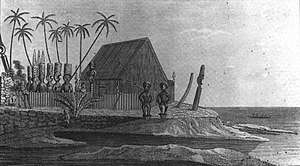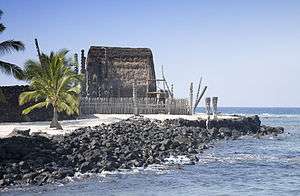Hale o Keawe


Hale o Keawe was an ancient Hawaiian heiau originally built in approximately 1650 AD[1] as the burial site for the ruling monarch (aliʻi nui) of the Island of Hawaii named Keaweʻīkekahialiʻiokamoku.[2] The complex may have been established as early as 1475 under the aliʻi nui ʻEhu-kai-malino. Radio carbon dating has not been done extensively in the area. Testing of the nearby 'Āle'ale'a heiau site gave deceptive results. Oral traditions compiled by Dorothy Barrère are still considered the best for chronological order of the surrounding complex.[3][1]
The heiau contained 23 remains including that of Keaweʻīkekahialiʻiokamoku. It was situated near a great ancient wall near the royal residence to the east side of the wall. Further south were further aliʻi homes were built. Excavations of the area indicate a large crafting community to support the royal residence.[4] The heiau would lay untouched after the banning of the Hawaiian religion while all other such temples were destroyed until Kaahumanu had the building dismantled and all the remains moved to the royal mausoleum in Honolulu.[5]
Today the reconstructed temple is part of the Puʻuhonua o Hōnaunau National Historical Park.[6][2]
References
- 1 2 Patrick Vinton Kirch (1997). Feathered Gods and Fishhooks: An Introduction to Hawaiian Archaeology and Prehistory. University of Hawaii Press. p. 162. ISBN 978-0-8248-1938-5.
- 1 2 Pu'uhonua-o-Honaunau, City of Refuge National Historic Park, Natural and Cultural Resources Management Plan and Environmental Assessment (EA). 1976. pp. 25–26.
- ↑ Patrick Vinton Kirch (1996). Legacy of the Landscape: An Illustrated Guide to Hawaiian Archaeological Sites. University of Hawaii Press. p. 46. ISBN 978-0-8248-1739-8.
- ↑ Patrick Vinton Kirch (2 December 2010). How Chiefs Became Kings: Divine Kingship and the Rise of Archaic States in Ancient Hawai'i. University of California Press. p. 169. ISBN 978-0-520-26725-1.
- ↑ Robert F. Oaks (1 November 2003). Hawai'i: A History of the Big Island. Arcadia Publishing. p. 22. ISBN 978-1-4396-1403-7.
- ↑ Ala Kahakai National Trail, Hawaii County: Environmental Impact Statement. 1998. p. 1.